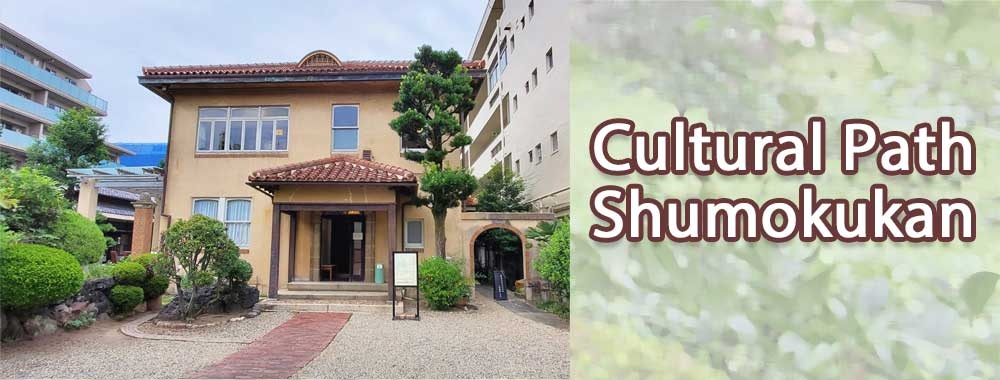2020.10.29

In the Edo period (1603-1868), the area between Nagoya Castle and Tokugawaen was a residential area for middle and lower-class samurai. Through the Meiji (1868-1912), Taisho (1912-1926) and early Showa periods (1926-1989), the district became a stage for the interactions between modern industrial entrepreneurs, missionaries, journalists and other important figures.
Now dubbed the Bunka no Michi (文化のみち) or 'Cultural Path,' the area contains important historical assets including many buildings conveying Nagoya's journey of modernization through the Edo, Meiji and Taisho periods, a precinct for the preservation and utilization of this architectural heritage.
The Cultural Path Shumokukan is one such architectural asset, and, as the former residence of ceramic merchant Imoto Tamesaburo (井元為三郎), an important reminder of the significance of pottery and porcelain production and export for the region during the early 20th century.
 The present-day Cultural Path Shumokukan retains much of its original appearance when constructed in the 1920s. Within the grounds remain Japanese- and Western-style buildings, a pair of earthen-walled storehouses, a tea ceremony room, and a garden. The residence was designated a Tangible Cultural Asset of the City of Nagoya in 1996, and a Structure of Landscape Importance in March 2008.
The present-day Cultural Path Shumokukan retains much of its original appearance when constructed in the 1920s. Within the grounds remain Japanese- and Western-style buildings, a pair of earthen-walled storehouses, a tea ceremony room, and a garden. The residence was designated a Tangible Cultural Asset of the City of Nagoya in 1996, and a Structure of Landscape Importance in March 2008.
In the Edo period this was a residential district for the samurai class, divided into blocks of land of around 2,000 square meters each. The generous space, proximity to the main routes to the famous centers of ceramic production of Seto and Tajimi, as well as convenient access to the Horikawa River and transport by water drew pottery and porcelain painting and processing companies to the area from the mid-Meiji period. By the early Showa period, there were more than 600 ceramic painting factories in and around Higashi Ward, with the area producing 70 to 80 percent of Japan's ceramic exports at the industry's peak.
The Shumokukan residence was built with the wealth Imoto Tamesaburo amassed through his successful pottery and porcelain business. Born in 1873, Imoto Tamesaburo began working at a store belonging to the Arita group at the age of 16, and in 1897 established his own business, Imoto Shoten, in Iida-machi, a neighborhood adjoining Shumoku-cho, at the age of 24. (The company currently operates as Imoto Sangyo Ltd.) In the early twentieth century, Imoto established a trading company in San Francisco, and began operations in Singapore and Burma exporting medical and pharmaceutical products and sundry goods in addition to pottery and porcelain. In 1924, Imoto was appointed the chairman of the Nagoya Pottery and Porcelain Exporters Guild. Counted as one of the five key agents in pottery and porcelain processing and handling, Imoto was a leading figure in the pottery and porcelain industry. "Happiness is within my heart" is said to have been the easy-going and broadminded Imoto's motto.
Stained glass is featured extensively in Shumokukan's Western-style building, where Imoto is said to have invited numerous buyers to discuss exports of pottery and porcelain ware. One second-floor room is now an exhibition room where visitors can see examples of porcelain ware produced locally for export and the various stages of porcelain painting and processing.
As many of the area's old residences were destroyed, between 1996 and 2002 Shumokukan had five tenants who opened the premises to the public and organized a variety of cultural events. Although temporarily closing, in 2004 it came under the management of a citizens' group and has since hosted various community-organized activities. After being acquired by Nagoya City in 2007, repairs were made and Shumokukan was once again opened to the public in July 2009.
Cultural Path Shumokukan
When: Open 10:00 - 17:00. Closed Mondays (or the following weekday when Monday is a national holiday), 29 Dec. to 3 Jan.
Admission: Adults 200 Yen (Combined admission ticket to Cultural Path Shumokukan and Cultural Path Futaba Museum 320 Yen); Residents of Nagoya City aged 65 and over 100 Yen (combined ticket 160 Yen); Junior HS-aged children and younger free; Holders of a Certificate of Disability free. Other discounts available.
Access: A 10-minute walk north from Takaoka Sta. (高岳駅, S06) Exit 1 or 2, Subway Sakura-dori Line (地下鉄桜通線) / A 12-minute walk south from Amagasaka Sta. (尼ケ坂駅, ST04), Meitetsu Seto Line (名鉄瀬戸線) / A 3-minute walk from Nagoya Sightseeing Route Bus Me-guru (なごや観光ルートバス メーグル) Cultural Path Futaba Museum (文化のみち二葉館) stop
Website: https://www.shumokukan.city.nagoya.jp/index.html




